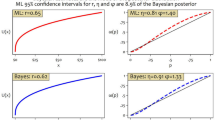Abstract
Individuals’ risk preferences are estimated and employed in a variety of settings, notably including choices in financial, labor, and product markets. Recent work, especially in financial economics, provides estimates of individuals’ coefficients of relative risk aversion (R’s) in excess of one, and often significantly higher. However, it can be shown that high R’s imply equally high values for the income elasticity of the value of a statistical life. Yet estimates of this elasticity, derived from labor and product markets, are in the range of 0.5 to 0.6. Furthermore, it turns out that even an R below one is difficult to reconcile with these elasticity estimates. Thus, there appears to be an important (additional) anomaly involving individuals’ risk-taking behavior in different market settings.
Similar content being viewed by others
References
Arrow, Kenneth J. (1971). Essays in the Theory of Risk-Bearing. Chicago: Markham Publishing Co.
Barsky, Robert B., F. Thomas Juster, Miles S. Kimball, and Matthew D. Shapiro. (1997). “Preference Parameters and Behavioral Heterogeneity: An Experimental Approach in the Health and Retirement Study,” Quarterly Journal of Economics 112, 537–579.
Benartzi, Shlomo and Richard H. Thaler. (1995). “Myopic Loss Aversion and the Equity Premium Puzzle,” Quarterly Journal of Economics 110, 73–92.
Bernheim, B. Douglas, Katherine Grace Carman, Jagadeesh Gokhale, and Laurence J. Kotlikoff. (2003). “Are Life Insurance Holdings Related to Financial Vulnerabilities?” Economic Inquiry 41, 531–554.
Blake, David. (1996). “Efficiency, Risk Aversion and Portfolio Insurance: An Analysis of Financial Asset Portfolios Held by Investors in the United Kingdom,” Economic Journal 106, 1175–1192.
Brav, Alon, George M. Constantinides, and Christopher C. Geczy. (2002). “Asset Pricing with Heterogeneous Consumers and Limited Participation: Empirical Evidence,” Journal of Political Economy 110, 793–824.
Campbell, John Y. (1996). “Understanding Risk and Return,” Journal of Political Economy 104, 298–345.
Campbell, John Y. (2003). “Consumption-Based Asset Pricing.” In G.M. Constantinides, M. Harris, and R.M. Stulz (eds.), Handbook of the Economics of Finance: Financial Markets and Asset Pricing, Amsterdam: Elsevier, vol. 1B, pp. 803–887.
Chetty, Raj. (2003). “A New Method of Estimating Risk Aversion.” NBER Working Paper 9988.
Choi, E. Kwan and Carmen F. Menezes. (1992). “Is Relative Risk Aversion Greater than One?” International Review of Economics and Finance 1, 43–54.
Constantinides, George M. (1990). “Habit Formation: A Resolution of the Equity Premium Puzzle,” Journal of Political Economy 98, 519–543.
Costa, Dora L. and Matthew E. Kahn. (2004). “Changes in the Value of Life, 1940–1980,” Journal of Risk and Uncertainty 29, 159–180.
Davies, James B. (1996). “Explaining Intergenerational Transfers.” In P. L. Menchik (ed.), Household and Family Economics, pp. 47–82. Boston: Kluwer Academic Publishers.
Epstein, Larry G. and Stanley E. Zin. (1990). “First-Order’ Risk Aversion and the Equity Premium Puzzle,” Journal of Monetary Economics 26, 387–407.
Halek, Martin and Joseph G. Eisenhauer. (2001). “Demography of Risk Aversion,” Journal of Risk and Insurance 68, 1–24.
Hammitt, James K., Jin-Tan Liu, and Jin-Long Liu. (2000). “Survival is a Luxury Good: The Increasing Value of a Statistical Life.” (Unpublished manuscript.)
Kaplow, Louis. (2003a). “The Value of a Statistical Life and the Coefficient of Relative Risk Aversion.” NBER Working Paper 9852.
Kaplow, Louis. (2003b). “Concavity of Utility, Concavity of Welfare, and Redistribution of Income.” NBER Working Paper 10005.
Kocherlakota, Narayana R. (1996). “The Equity Premium: It’s Still a Puzzle,” Journal of Economic Literature 34, 42–71.
Maitel, Shlomo. (1973). “Public Goods and Income Distribution: Some Further Results,” Econometrica 41, 561–568.
Mankiw, N. Gregory. (1985). “Consumer Durables and the Real Interest Rate,” Review of Economics and Statistics 67, 353–362.
Mankiw, N. Gregory and Stephen P. Zeldes. (1991). “The Consumption of Stockholders and Nonstockholders,” Journal of Financial Economics 29, 97–112.
Masson, André, and Pierre Pestieau. (1997). “Bequest Motives and Models of Inheritance: A Survey of the Literature.” In Guido Erreygers and Toon Vandevelde (eds.), Is Inheritance Legitimate? Ethical and Economic Aspects of Wealth Transfers, pp. 54–88. Berlin: Springer-Verlag.
McGrattan, Ellen R. and Edward C. Prescott. (2003). “Average Debt and Equity Returns: Puzzling?” American Economic Review Papers and Proceedings 93, 392–397.
Mehra, Rajnish and Edward C. Prescott. (1985). “The Equity Premium: A Puzzle,” Journal of Monetary Economics 15, 145–161.
Meyer, Donald J. and Jack Meyer. (2004). “Relative Risk Aversion: What Do We Know?” (Unpublished manuscript.)
Pålsson, Anne-Marie. (1996). “Does the Degree of Relative Risk Aversion Vary with Household Characteristics?” Journal of Economic Psychology 17, 771–787.
Shrikhande, Milind M. (1997). “Non-addictive Habit Formation and the Equity Premium Puzzle,” European Financial Management 3, 293–319.
Stark, Oded. (1995). Altruism and Beyond: An Economic Analysis of Transfers and Exchanges within Families and Groups. Cambridge: Cambridge University Press.
Viscusi, W. Kip. (1994). “Mortality Effects of Regulatory Costs and Policy Evaluation Criteria,” Rand Journal of Economics 25, 94–109.
Viscusi, W. Kip and Joseph E. Aldy. (2003). “The Value of a Statistical Life: A Critical Review of Market Estimates throughout the World,”Journal of Risk and Uncertainty 29, 5–76.
Viscusi, W. Kip and William N. Evans. (1990). “Utility Functions that Depend on Health Status: Estimates and Economic Implications,” American Economic Review 80, 353–374.
Author information
Authors and Affiliations
Additional information
JEL Classification: D80, G11, G12, I10, J17
Rights and permissions
About this article
Cite this article
Kaplow, L. The Value of a Statistical Life and the Coefficient of Relative Risk Aversion. J Risk Uncertainty 31, 23–34 (2005). https://doi.org/10.1007/s11166-005-2928-1
Issue Date:
DOI: https://doi.org/10.1007/s11166-005-2928-1



